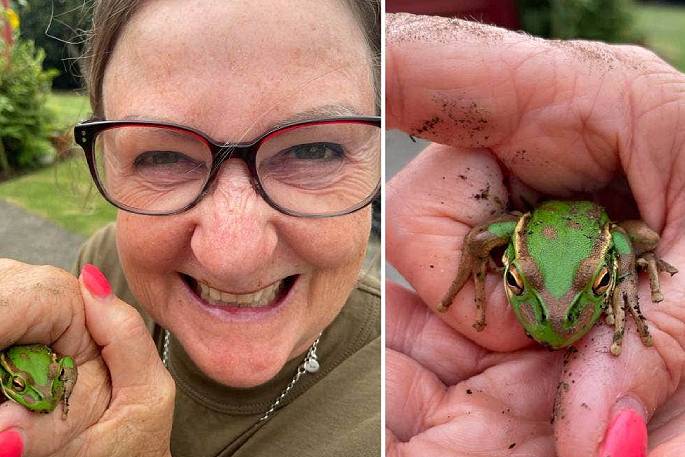A run of wet weather in the Bay of Plenty has triggered a series of amphibian home invasions.
Tania Nichols was startled when she heard a strange 'squeal” in her house.
'I went to investigate and saw a frog in the sun room. I caught it and took it outside so the cat wouldn't get it.”
It was the first frog she'd seen since she arrived in New Zealand seven years ago.
'I was really taken by surprise as I'd assumed that due to all the sprays that get used and never seeing any that there just aren't any.”
Other locals had told her there had been quite a few sightings lately. One man said he'd found 15 of the critters in his spa pool.
Kirsty Gordon was stunned to discover an amphibian at her front door.
'We were amazed to see the frog, as we are in a new build on the top of a hill with very little greenery about. The only garden we have currently is in our entryway, so we have no idea where the little frog came from!”
Jay Kay also had a visitor at the front door, greeted by his dog.
'Molly the collie likes to point them out to us. Frogs every time it rains. Numbers seem to have increased.”
Frogs announced themselves with a unique sound, says Chelsey Gee.
'They do come into the house if the doors are left open after dark. We are rural, and they show up on the windows when it's really wet like now ... I love the sound they make at night.”
Frog fan Sue Shoemack hasn't never seen them at her place until recently.
'My husband Phil found one under one of our avocado trees near our house and knows I love them.”
The influx of frogs was likely due to wet weather, says Sam Purdie, a herpetologist and committee member of New Zealand Herpetological Society.
'Rainy and humid conditions are ideal for the emergence of frogs. Most frogs have very permeable skin, which needs to stay relatively moist. The summer months are when they breed, and damp conditions tend to facilitate the movements of these frogs.”
It is unusual for frogs to take up residence inside homes, he says.
'Frogs that end up in people's houses are likely moving around between water bodies or have been brought in by household pets.”
Sam advises people who find them inside to return them outdoors.
'If a frog ends up in your house, carefully release it back into the garden, somewhere relatively damp with some vegetation, or in a pond if you have one, and the frog will likely find its way about. Sometimes frogs will get covered in bits of hair and debris. If you have some non-chlorinated water such as rainwater, carefully rinse off the frog before releasing it.”
Non-native frogs are common in New Zealand, but frogs are endangered species elsewhere in the world, he says.
'Most of the frogs people are seeing are exotic species that were introduced to Aotearoa within the last couple of hundred years.”
In the Bay of Plenty, these will mostly be green and golden bell frogs (Ranoidea aurea) or southern bell frogs (Ranoidea raniformis).
Although these frogs are relatively common in New Zealand, they are threatened in Australia.
The International Union for Conservation of Nature lists these two species as vulnerable and endangered.
With frog populations declining globally, Sam says native frogs need attention.
'New Zealand's native frogs belong to one of the world's most ancient family of frogs - Leiopelmatidae. This lineage of frog likely evolved more than 180 million years ago. When humans arrived in Aotearoa, at least six species of Leiopelmatidae existed. Three of these have become extinct and we now only have three native frog species left. So, they are now quite rare and unfortunately, most people in New Zealand will never see a native frog.”
One of the native species – Hochstetter's frogs – do occur in the Bay of Plenty region but are mostly aquatic.
'If people have native frogs in their area, they can help them by trapping mammalian predators, ensuring habitat doesn't get destroyed or polluted, and can also help by disinfecting shoes to the indigenous forest habitat where many of these marvellous creatures live.”



1 comment
Trapping predators
Posted on 04-02-2023 13:35 | By Sycamore2
Mammalian predators include dogs and cats, I can't see trapping them going down well.
Leave a Comment
You must be logged in to make a comment.